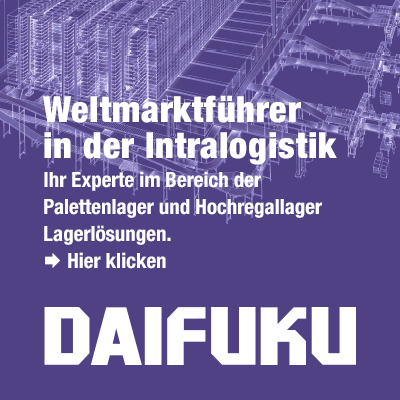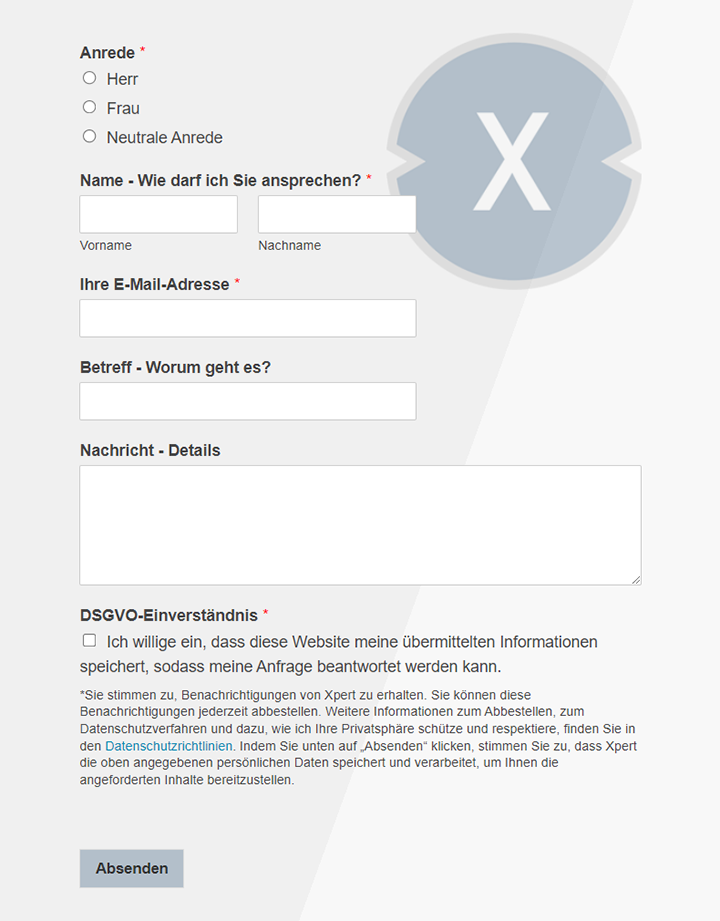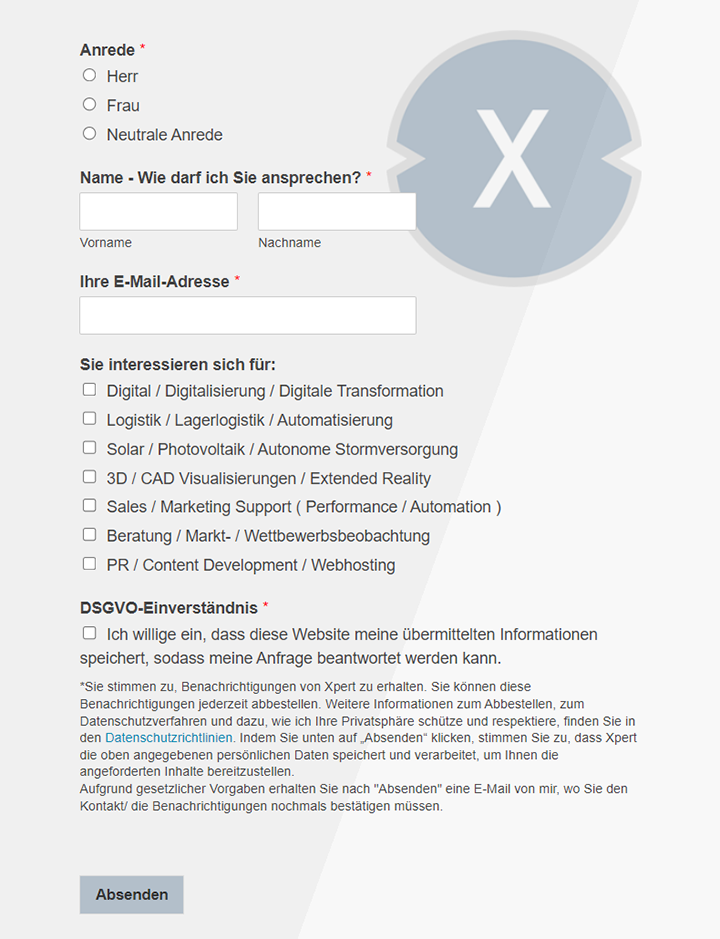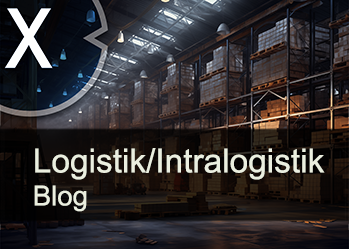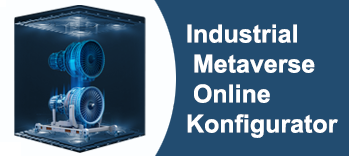Real chain chaos: How market fragmentation endangers food and pharmaceutical security (and what we can do about it)
Xpert pre-release
Language selection 📢
Published on: February 8, 2025 / update from: February 8, 2025 - Author: Konrad Wolfenstein

Real chain chaos: How market fragmentation endangers food and pharmaceutical security (and what we can do about it)- Image: Xpert.digital
How market fragmentation slow down the cold chain - solutions and perspectives
Icy challenge: market fragmentation and their effects on supply chains
In many regions, market fragmentation represents one of the central challenges for optimizing the cold chain. It causes inefficiencies, unequal technological standards and a tightened competitive pressure, which in turn significantly affects the safety and efficiency of temperature -managed supply chains.
Challenges through market fragmentation
1. Resource of resources in SMEs
Small and medium -sized companies (SMEs) dominate cooling logistics in many countries. In Italy in particular, many of these companies use outdated infrastructure and do not have the financial means to invest in smart cooling technologies or digitization. This leads to considerable quality differences within the supply chain.
2. Competition pressure and investment gaps
In the United Arab Emirates (VAE), local providers are in direct competition with multinational groups, which leads to unequal market conditions. Regional companies can often not keep up with the extensive investments in modern storage infrastructure or highly developed temperature control systems.
3. Technological fragmentation
In China, the lack of compatibility between proprietary systems is a major problem. Different monitoring solutions hinder the integration of cold chain systems. Currently, only 51 % of agricultural products in China are moved over chilled transports, which leads to high food losses.
Strategies to overcome fragmentation
Strategies for overcoming fragmentation include various approaches that achieve specific effects: through cooperation, for example, Italian SMEs form alliances with technology providers, which enables scale effects and joint research and development. State funding, such as China's subsidies for modern cooling chain technologies, allow smaller companies to invest in high-tech solutions. Technological integration, such as the development of the Lynx platform by carrier and AWS, unites data flows and reduces transport losses by 15–20 %.
Technological innovations such as blockchain (Spain) or automated cooling stores (Daifuku) help to increase transparency and enable more precise temperature monitoring. Regulatory initiatives in Europe and North America are also driving the standardization of cooling logistics.
Nevertheless, the limited scalability of many local solutions remains a problem, especially in Africa, where the infrastructure is particularly weak. In the long term, the successful optimization of the cold chain depends on whether fragmented markets can be standardized through industry -wide cooperation and interoperable technologies.
Suitable for:
Effects of market fragmentation on the cold chain
1. Logistical inefficiencies
- Extended transport times: In China, 23 % of the agricultural products lose their cooling consistency because they often have to be reloaded.
- Energy waste: In Italy, 68 % of the KMUS uses outdated refrigerated vans with an energy consumption of 30–40 % than modern systems.
2. Technological inconsistencies
- Incompatible monitoring systems: Proprietary IoT solutions make real-time optimizations difficult.
- A lack of automation: Only 12 % of African cooling logistics providers use automated warehouse, which often leads to temperature fluctuations.
3. Economic scaling barriers
- Missing investment power: Small providers can only apply 15–20 % of the costs for predictive maintenance or blockchain tracking.
- Fragmented demand: In Brazil, more than 80 regional cooling providers serve local markets, which leads to unused cooling stores.
4. Security and quality risks
- Temperature deviations: Studies show that fragmented supply chains exceed critical temperature limits up to 4.7 times more often.
- Documentation gaps: Inconsistent protocols lead to incorrect HACCP documentation for cross-border transports.
Cumulative effects
These factors reduce the efficiency of the cold chain by 18–25 %. Cloud -based platforms such as Lynx Digital Hub can increase the efficiency of fragmented networks by up to 30 %.
Successful strategies in fragmented markets
1. Niche focus and differentiation
- Segmented target group address: targeted strategies for special customer segments.
- Product differentiation: specialized solutions for pharmaceutical cooling logistics.
- Quality leadership: premiumization of certain segments such as organic food.
Suitable for:
2. Technological integration
Technological integration in the cold chain brings numerous advantages. IoT sensors enable real-time temperature control in logistics, which reduces losses by 15–20 %. AI-based CRM systems improve personalized customer forecasts and increase the conversion rates by 30 %. In addition, blockchain technology creates transparent supply chains and thus enables premium prices with an increase of 18 %.
3. Cooperation models
- Buy & Build strategies: Integration of smaller companies to increase the scale effects.
- Technology partnerships: Cooperation with cloud providers to reduce investment costs.
- Industry alliance: Common use of cooling stores reduces fixed costs by up to 40 %.
4. Agile cost leadership
- Decentralized production: Micro-factories reduce storage costs.
- Dynamic Pricing: Real-time price optimization increases the load by 25 %.
- Energy efficiency programs: Conversion to solar cooling houses sustainably reduces operating costs.
5. Regulatory design
- Lobbying for standards: uniform IoT protocols in EU cooling logistics.
- Subscription programs: grants for sustainable cooling stores.
- Certification systems: sustainability label to increase consumer acceptance.
Digital technologies can help to reduce the fragmentation of the cold chain by increasing transparency, minimizing inefficiencies and enabling scale effects. Companies that adapt flexibly will benefit from these developments in the long term.
Xpert partner in warehouse planning and construction
The tear test of the cold chain: market fragmentation as a central challenge for efficiency and security - background senses
The cold chain: Invisible backbone of the global economy - focus on challenges in the focus
The cold chain, an invisible but essential nervous system of modern global economy, ensures the quality and safety of temperature -sensitive goods - from fresh food and life -saving drugs to chemical and electronic components. However, this complex, globally interlinked infrastructure is drawn from a profound challenge in many regions and industries: market fragmentation. This structural fragmentation, which is characterized by a variety of small and medium -sized companies (SMEs), divergent technological standards and intensive competitive pressure, undermines the efficiency, reliability and ultimately the safety of the entire temperature -guided supply chain.
Market fragmentation does not manifest itself as a singular problem, but as a complex network of structural, technological and economic barriers. This fragmentation of the market leads to a number of inefficiencies that run through the entire cold chain like a thread and sensitively impair their performance and resilience.
The multi -layered challenges of market fragmentation in detail
The fragmentation of the cold chain market is a multi -layered phenomenon, the effects of which can be felt in various areas of logistics and business. In order to understand the full extent of the problem, it is essential to take a closer look at the central challenges:
1. Resource of resources and the dominance of SMEs: the Italian paradox
In many regions, especially in Europe, cold chain logistics are strongly dominated by small and medium -sized companies (SMEs). Italy serves as a concise example. Although Italy is an important economic power and an important actor in global trade, its cooling logistics industry is characterized by a large number of SMEs. These companies, often family businesses with a long tradition, have valuable know-how and local expertise, but often fight with outdated infrastructure and limited financial resources.
The consequence of this resource inequality is serious: Italian SMEs are often unable to invest in modern "smart cooling" technologies, digital surveillance systems or energy-efficient means of transport. This leads to considerable quality differences within the supply chain. While large, globally operating logistics groups operate with the latest technologies and standardized processes, many Italian SMEs are dependent on older, less efficient methods. This technological gap not only leads to higher operating costs and less energy efficiency, but also to an increased risk of temperature fluctuations and product losses. The fragmentation of the market in Italy manifests itself in a two -class society of cooling logistics, in which efficiency and quality depend heavily on the size and financial possibilities of the individual actors.
2. Competition pressure and investment gaps: The unequal playing field of the VAE
Another multifaceted example of the challenges of market fragmentation can be found in the United Arab Emirates (VAE). The VAE, a dynamic economic area and an important transshipment point in global trade, are characterized by an intensive competition in the cooling logistics industry. Here local providers compete for market shares with multinational groups. This competition, which is to be evaluated in principle, leads to unequal conditions in a fragmented market.
Multinational corporations have immense financial resources, global networks and the latest technologies. You can invest in a large scale in storage infrastructure, advanced temperature control systems and comprehensive IT solutions. Regional companies in the VAE, often SMEs or medium -sized companies, simply cannot keep up with these investments. They face the challenge of being in competition without having the same financial and technological options. This investment gap means that regional providers are often forced to make cuts in the quality of their services, the modernity of their infrastructure or the energy efficiency of their systems. Paradoxically, competitive pressure in a fragmented market can thus hinder innovation and progress, since it pushes smaller actors into a position of inferiority and complicates the development of a homogeneous, high -quality cold chain infrastructure.
3. Technological fragmentation and proprietary systems: China's integration dilemma
China, the most populous state in the world and a global economic power, faces unique challenges in the area of cold chain logistics, which are largely characterized by technological fragmentation. While China has made enormous progress in the modernization of its logistics infrastructure in recent decades, proprietary systems and lack of compatibility between different surveillance solutions hinder the seamless integration of the cold chain.
In China there is a large number of providers of cold chain technologies, from sensors and surveillance systems to software platforms and data analysis tools. However, many of these providers develop and implement proprietary systems that are not compatible with each other. This technological fragmentation leads to "data islands", in which valuable information about the temperature, location and state of goods along the supply chain can remain isolated and cannot be used across the board. The lack of interoperability complicates the creation of a comprehensive, transparent surveillance system that covers the entire cold chain from start to finish.
The consequence of this technological fragmentation is considerable inefficiency. Real -time optimizations based on the analysis of comprehensive data streams are blocked. The traceability of products is difficult and the risk of temperature fluctuations and product losses increases. An alarming example of the effects of this inefficiency is the fact that only about 51 % of the agricultural products are moved over chilled transports in China. This leads to considerable food loss and affects the quality and safety of food supply. Technological fragmentation in China illustrates that technological innovation alone is not sufficient to ensure an efficient cold chain. Interoperability, standardization and uniform protocols are also crucial to fully exploit the advantages of modern technologies and to promote the integration of the cold chain.
Suitable for:
Strategies to overcome fragmentation: paths to an integrated cold chain
In view of the complex challenges of market fragmentation, innovative and comprehensive strategies are required to optimize the cold chain and to ensure their efficiency and security. Fortunately, there are promising approaches that, if they are consistently implemented, have the potential to overcome fragmentation and create an integrated, resistant cold chain.
1. Cooperations and alliances: Together more in competition
Cooperations and alliances play a crucial role in fragmented markets that are dominated by SMEs. Italian SMEs, which merge into alliances with technology providers, impressively demonstrate the advantages of this approach. By bundling their resources and their know-how, SMEs can realize size advantages that were denied them individually. Common research and development (F&E) enables you to invest in innovative technologies and to modernize yourself faster. These cooperation can take different forms, from strategic partnerships and joint ventures to industry consortia and cooperatives. The key to success lies in the willingness to cooperate, the exchange of knowledge and the common use of resources in order to compensate for individual weaknesses and maximize the collective strength.
2. State funding and incentives: The state as a catalyst for innovation
State funding and targeted incentives are essential to drive the modernization of the cold chain, especially in fragmented markets. China's subsidies for cooling chain equipment and energy efficiency standards serve as an exemplary model. Through financial support and clear guidelines, the Chinese government encourages companies to invest in modern technologies and to implement energy -efficient practices. This state intervention is particularly important for SMEs, which often do not have the financial means in order to manage the initial investment costs for high technology. State funding can be carried out in the form of direct subsidies, tax relief, low -interest loans or funding programs for research and development. In addition, state initiatives for standardization and regulation play a crucial role in establishing uniform quality standards and creating fair competitive conditions. The state can thus act as a catalyst for innovation and modernization and accelerate the transformation of the cold chain towards more efficiency and sustainability.
3. Technological integration and digital platforms: Lynx as pioneer of networking
Technological integration, in particular through digital platforms and the Internet of Things (IoT), is another key to overcoming market fragmentation. The development of the Lynx platform by carrier and AWS is an outstanding example of this approach. Lynx is a cloud-based platform that combines IoT sensors, real-time analysis and artificial intelligence (AI) in order to enable comprehensive monitoring and control of the cold chain. By standardizing data streams from various sources and the provision of real -time information for everyone involved along the supply chain, Lynx contributes significantly to reducing transport losses and increasing efficiency. It is estimated that the use of such platforms can reduce transport losses by 15–20 %. However, technological integration goes beyond individual platforms. It includes the implementation of open standards and protocols that ensure the interoperability between different systems and providers. Only through comprehensive networking and data exchange can the advantages of digital technologies be fully exploited and the fragmentation of the cold chain can be overcome sustainably.
Digital solutions as a bridge builder in fragmented networks
Digital solutions such as blockchain and automated cooling stores are more than just technological progress; They are bridge builders in fragmented networks. Blockchain technology, such as it is used in Spain, increases the transparency and traceability in the cold chain to a previously unmatched level. By creating an unchangeable, decentralized recording of all transactions and events along the supply chain, blockchain enables complete tracking of products and strengthens the trust of consumers. Automated cooling stores, as developed by companies like Daifuku, revolutionize warehousing in the cold chain. By using robotics, sensors and intelligent software, you enable precise temperature monitoring, optimized inventory management and minimize manual interventions, which reduces the risk of errors and temperature fluctuations. These digital solutions, together with other innovations such as AI-based route planning and predictive maintenance, make a significant contribution to improving the efficiency and resilience of fragmented cold chains.
Regulatory initiatives as drivers of standardization
In parallel to technological innovations, regulatory initiatives play a crucial role in the standardization and harmonization of the cold chain. In Europe and North America, requirements for food safety and CO₂ reduction in cooling logistics are driving the development of uniform standards and practices. These regulatory framework creates an incentive for companies to invest in modern technologies, to implement energy -efficient processes and to increase the transparency of their supply chains. Examples of such initiatives are the EU Food Safety Ordinance, the HACCP guidelines (Hazard Analysis and Critical Control Points) and increasingly stricter environmental requirements for reducing greenhouse gas emissions. Regulatory initiatives are not only essential for compliance with minimum standards, but also promote innovation and competition by creating uniform rules of the game for all actors and promoting the development of a sustainable, safe and efficient cooling chain.
The challenge of scalability and global perspective
Despite the promising progress and the positive effects of digital solutions and regulatory initiatives, the lack of scalability of local solutions remains a problem, especially in regions with large infrastructure gaps such as Africa. Many of the previously developed and implemented solutions are tailored to specific regions or industries and cannot be easily transferred to other contexts. In Africa, where the infrastructure is often inadequate, cooling capacities are limited and there are high energy costs, the challenges are particularly large. This requires tailor -made solutions that take the local conditions into account and are tailored to the specific needs of African markets. In the long term, the successful optimization of the cooling chain will depend on whether it is possible to standardize fragmented markets not only through industry -wide cooperation and interoperable technologies, but also to develop scalable solutions that can be used globally and take into account the specific challenges of different regions.
Suitable for:
The efficiency brake market fragmentation: logistical, technological and economic barriers
The market fragmentation acts like an efficiency brake on the cold chain. It manifests itself in structural, technological and economic barriers that are shown in various key areas and impair the performance of the entire supply chain. These barriers should not be considered isolated, but interact with each other and reinforce each other, which creates a complex network of inefficiencies.
1. Logistic inefficiencies: extended transport times and energy waste
In fragmented regional markets, which are characterized by a variety of small players, logistical inefficiencies inevitably occur. Frequent umbrellas between uncoordinated cooling areas are the rule, not the exception. These um loads not only significantly extend the transport times, but also increase the risk of temperature fluctuations and damage to the products. In China, for example, 23 % of agricultural products lose their cooling consistency due to inefficiencies in the cold chain during transport. These losses are not only economically harmful, but also have a significant impact on food safety and sustainability.
Another serious problem of logistical inefficiency is the waste of energy. In Italy, where SMEs dominate the cooling logistics, according to estimates, 68 % of the SME uses outdated refrigerated vans. These older systems consume 30–40 % more energy than modern, energy -efficient refrigerated transporters. The waste of energy in fragmented cold chains is not only an ecological problem, but also a significant cost factor for companies. Higher energy costs reduce profitability and competitiveness, especially for SMEs that are already fighting with scarce resources.
2. Technological inconsistencies: incompatible systems and lack of automation
The technological fragmentation, which has already been identified as a central challenge, also leads to considerable inconsistencies within the cold chain. Incompatible monitoring systems, such as those created by proprietary IoT solutions from various providers (e.g. Carrier vs. Daikin), are a typical example. These systems generate isolated data that cannot be replaced. The result is "data silos" that block real -time optimizations and comprehensive analyzes. The lack of interoperability prevents the creation of a continuous, transparent monitoring system that covers the entire cold chain and enables data -driven decision -making.
Another problem of technological inconsistency is a lack of automation, especially in developing countries. In Africa, for example, estimates that only around 12 % of the cooling logistics providers use automated warehouses. The low distribution of automation leads to a high need for manual interventions, which increases the susceptibility to errors and increases the risk of temperature fluctuations and product damage. Automated warehouse and transport systems, on the other hand, enable more precise temperature control, more efficient inventory management and a reduction in labor costs. The technological inconsistency in fragmented markets thus brakes the progress towards a more efficient, more reliable and more sustainable cold chain.
3. Economic scaling barriers: lack of investment and fragmented demand
Market fragmentation also creates considerable economic scaling barriers, which in particular restrict SME in their competitiveness. A lack of investment is a central problem. Small providers in fragmented markets, such as in the VAE, can often only apply a fraction of the costs of modern technologies such as predictive maintenance or blockchain-based tracking that are used by large, multinational corporations. This investment gap causes SMEs to lag behind technologically and their competitiveness decreases compared to larger actors.
Another economic problem is the fragmented demand. In Brazil, for example, over 80 regional cooling logistics providers serve local markets. This fragmentation of demand leads to inefficient transport routes, empty trips (estimates 38 % of the transport capacity) and unused cooling stores. The low utilization of resources drives the costs per unit and reduces profitability. The economic scaling barriers in fragmented markets thus prevent the implementation of efficiency gains and the optimization of the cold chain as a whole.
4. Quality and security risks: temperature deviations and documentation gaps
The cumulative effects of logistical, technological and economic barriers finally manifest themselves in increased quality and security risks. Temperature deviations are a particularly serious problem. Spanish studies show that fragmented supply chains exceed critical temperature limits 4.7 times more often than integrated systems. These temperature crossings can affect the quality and durability of food, reduce the effectiveness of pharmaceuticals or even lead to health risks. The increased likelihood of temperature deviations in fragmented cold chains endangers the safety and quality of the products and undermines the trust of consumers.
Another quality and security risk are documentation gaps. In Southeast Asia, for example, inconsistent protocols and a lack of standardization are estimated to lead to 27 % faulty HACCP documentation for cross-border refrigerated transports. Incomplete or incorrect documentation complicates the traceability of products, compliance with legal regulations and the effective reaction to potential security incidents. Documentation gaps in fragmented cold chains thus increase the risk of quality problems, recalls and legal consequences.
Cumulative effects and the potential of digital integration
The cumulative effects of these logistical, technological, economic and safety -relevant factors lead to a significant reduction in the overall efficiency of the cold chain in fragmented markets. An EU estimate from 2024 puts this loss of efficiency to 18–25 %, measured by energy consumption, product loss and delivery times. This considerable loss of efficiency underlines urgency to overcome market fragmentation and optimize the cooling chain.
However, solutions such as the Lynx digital hub of Carrier and AWS impressively demonstrate that cloud-based integration has the potential to significantly increase the efficiency of fragmented networks. By standardizing data streams, the provision of real-time information and the use of AI-based analysis, digital platforms can improve the efficiency of fragmented cold chains by up to 30 %. These promising results show that technological innovation and digital integration are key strategies in order to cope with the challenges of market fragmentation and to design a more efficient, safer and sustainable cold chain of the future.
Suitable for:
Strategies for more competitiveness in fragmented markets
The increase in competitiveness in fragmented markets requires tailor -made strategies that specifically respond to the specific challenges such as resource inequality, technological fragmentation and limited scale effects. Based on the approaches previously analyzed, critical strategies can be identified that can help companies assert themselves in fragmented markets and to grow successfully.
1. Niche focus and differentiation: The art to stand out
In fragmented markets in which competition is often intensive and the price pressure is high, niche focus and differentiation is an essential strategy. A segmented target group address in which targeted marketing strategies are developed for clearly defined customer segments can increase the loyalty to the brand and strengthen customer loyalty. Examples of this are fast-casual dining in gastronomy or sustainable fashion in retail. By focusing on specific needs and preferences of certain customer groups, companies can use their marketing budgets more efficiently and build more customer loyalty.
Product differentiation, i.e. specialization in unfulfilled needs, is another important strategy. Carrier, for example, has made a name for itself with IoT-based cooling logistics solutions for pharmaceutical supply chains. By concentrating on a specific niche with high requirements and specialized needs, Carrier was able to obtain a leading position in this segment and stand out from generic providers.
Quality leadership, i.e. premiumization in partial markets, is a third strategy for differentiation. Examples of this are organic food or luxury electric vehicles. Due to the focus on the highest quality and exclusivity, companies can achieve higher margins, even if the target group size is limited. Quality leadership enables companies to escape the price pressure and build a loyal customer base that is willing to pay a premium price for superior products and services.
2. Technological integration: digital tools for competitive advantages
Technological integration is not only an answer to fragmentation, but also a source for competitive advantages. The use of IoT sensors for real-time temperature monitoring in logistics reduces product losses by 15–20 %. This reduction of losses not only leads to cost savings, but also improves the quality and safety of the products and strengthens the trust of customers.
AI-based CRM systems (Customer Relationship Management) enable personalized customer forecasts in e-commerce and increase the conversion rates by up to 30 %. By analyzing customer data and predicting customer needs, companies can optimize their marketing activities, create personalized offers and increase customer satisfaction.
Blockchain technology creates transparent supply chains in the food industry and enables premium prices of up to 18 % more. The increased transparency and traceability that blockchain offers strengthens consumers' trust in the quality and safety of the products and enables companies to stand out from the competition and achieve premium prices. Technological integration is therefore a strategic lever to generate competitive advantages, increase efficiency and strengthen customer loyalty.
3. Cooperation models: Together for success
Cooperation models play a crucial role in competitiveness in fragmented markets. Buy & Build strategies, in which larger companies acquire smaller players to create critical mass, are widespread in German medium-sized companies. By acquisitions, companies can expand their market shares, realize synergy effects and strengthen their competitive position.
Technology partnerships in which SMEs cooperate with cloud providers (e.g. AWS Lynx Digital Hub) enable inexpensive access to predictive maintenance and other advanced technologies. Partnerships can benefit from the resources and the know-how of large technology companies through partnerships without having to make high investments in their own IT infrastructure.
Industry alliances in which companies together use cooling stores or transport capacities, such as practiced in pharmaceutical logistics, use up to 40 %. Through the common use of resources, companies can reduce costs, increase efficiency and improve their competitiveness. Cooperation models enable companies to overcome the disadvantages of market fragmentation and to be successful together.
4. Agile cost leadership: efficiency as a competitive advantage
Agile cost leadership, i.e. the ability to efficiently manage costs and react flexibly to market changes, is another important strategy for fragmented markets. Decentralized production with micro-factories in the clothing industry reduces storage costs through on-demand production. By moving production closer to consumers and production on order, companies can minimize inventory, shorten delivery times and reduce costs.
Dynamic Pricing, in which algorithms adapt prices in real time (e.g. transferring in the hospitality industry), increases utilization rates by up to 25 %. With the flexible adaptation of prices to demand, companies can better utilize their capacities, maximize sales and increase their profitability.
Energy efficiency programs, such as subsidized conversions to solar cooling houses in Africa, sustainably reduce operating costs. By investing in energy -efficient technologies, companies can reduce costs, improve their environmental balance and secure their long -term competitiveness. Agile cost leadership enables companies to differentiate themselves in fragmented markets by efficiency, flexibility and sustainability.
5. Regulatory design: actively use fragmentation
Companies can also actively use fragmentation by helping shape regulatory framework conditions. Lobbying for standards, such as uniform IoT protocols in EU cooling logistics, can help improve interoperability and promote competition. By actively participating in the design of standards, companies can ensure that their interests are taken into account and that fair competitive conditions are created.
The development of subsidy programs, such as China's promotion of energy -efficient refrigerated transporters, can give companies financial advantages and facilitate investments in modern technologies. Through the proactive search for and using funding opportunities, companies can strengthen their innovative strength and improve their competitiveness.
The establishment of certification systems, such as sustainability labels in the food trade for rehabilitation, can enable companies to stand out from the competition and achieve higher prices. Certifications create trust in consumers and enable companies to communicate and monetize their quality and sustainability efforts. Regulatory design is therefore a strategic tool to actively use fragmentation and generate competitive advantages.
Digital lever and platform economy: fragmentation as an opportunity
Digital levers such as AI-based market analyzes allow companies to recognize fragmentation trends early. The development of micro markets for vegan drug cooling is an example of such trends. Thanks to the early identification of niche markets, companies can adapt their strategies and open up new growth opportunities.
Platform economics models, such as freight exchanges in logistics, enable the bundling of fragmented demand. Through digital platforms, companies can bring together supply and demand more efficiently, reduce empty trips and reduce costs. The platform economy thus offers solutions for inefficiencies that arise from market fragmentation and converts fragmentation into an opportunity for more efficiency and flexibility.
Hybrid strategies and long -term success: modularity as a key
In the long term, companies prevail that develop hybrid strategies from differentiation and cost efficiency. Modular product architectures that enable scale effects despite marketing splinters are a key here. With modular designs, products and services can be designed in such a way that they can be adapted to the specific needs of different market segments while at the same time using scale effects in production and logistics. This hybrid strategy enables companies to be both differentiated and cost -effective and thus secure a sustainable competitive advantage in fragmented markets.
Fragmentation as a transformation accelerator
Market fragmentation in the cold chain is undoubtedly a significant challenge that causes inefficiencies, risks and costs. But it is not only an obstacle, but also a catalyst for innovation and transformation. Companies that accept fragmentation as a reality and adapt proactively can not only survive in this environment, but also be successful and grow.
The keys to success in fragmented cold chain markets lie in a combination of strategic foresight, technological innovation and partnership cooperation. Niche focus and differentiation enable companies to stand out from the crowd and meet specific customer needs. Technological integration through IoT, AI, blockchain and cloud platforms creates transparency, efficiency and new competitive advantages. Cooperation models and industry alliance bundle resources and know-how to realize scale effects and strengthen innovative strength. Agile cost leadership and regulatory design enable companies to act flexibly, efficiently and sustainably.
In the long term, the cold chain of the future will be shaped by increasing integration, digitization and sustainability. The fragmentation will not completely disappear, but their negative effects can be significantly reduced by intelligent strategies and innovative technologies. The companies that actively shape this transformation, use the opportunities of digitization and rely on cooperation will dominate the cold chain of the future and make a decisive contribution to global security of care and sustainability. The fragmentation test is thus a stress test that releases the innovative strength of the cold chain industry and paves the way for a more efficient, more secure and more resistant, temperature -led logistics.
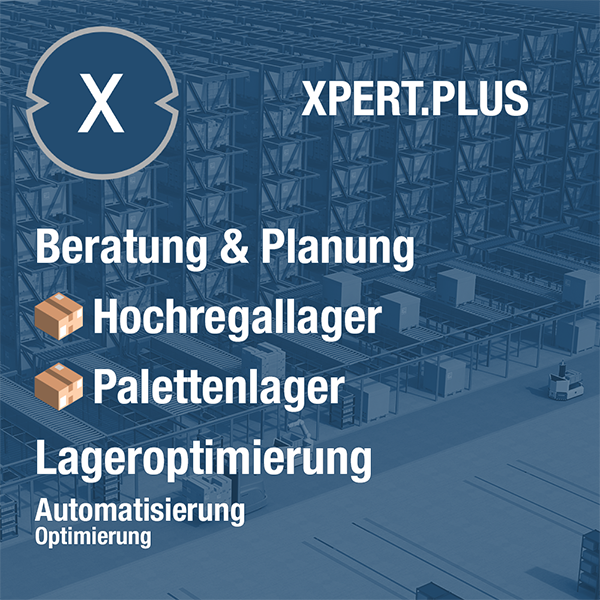
Xpert.Plus warehouse optimization - high-bay warehouses such as pallet warehouses consulting and planning
We are there for you - advice - planning - implementation - project management
☑️ SME support in strategy, consulting, planning and implementation
☑️ Creation or realignment of the digital strategy and digitalization
☑️ Expansion and optimization of international sales processes
☑️ Global & Digital B2B trading platforms
☑️ Pioneer Business Development
I would be happy to serve as your personal advisor.
You can contact me by filling out the contact form below or simply call me on +49 89 89 674 804 (Munich) .
I'm looking forward to our joint project.
Xpert.Digital - Konrad Wolfenstein
Xpert.Digital is a hub for industry with a focus on digitalization, mechanical engineering, logistics/intralogistics and photovoltaics.
With our 360° business development solution, we support well-known companies from new business to after sales.
Market intelligence, smarketing, marketing automation, content development, PR, mail campaigns, personalized social media and lead nurturing are part of our digital tools.
You can find out more at: www.xpert.digital - www.xpert.solar - www.xpert.plus



